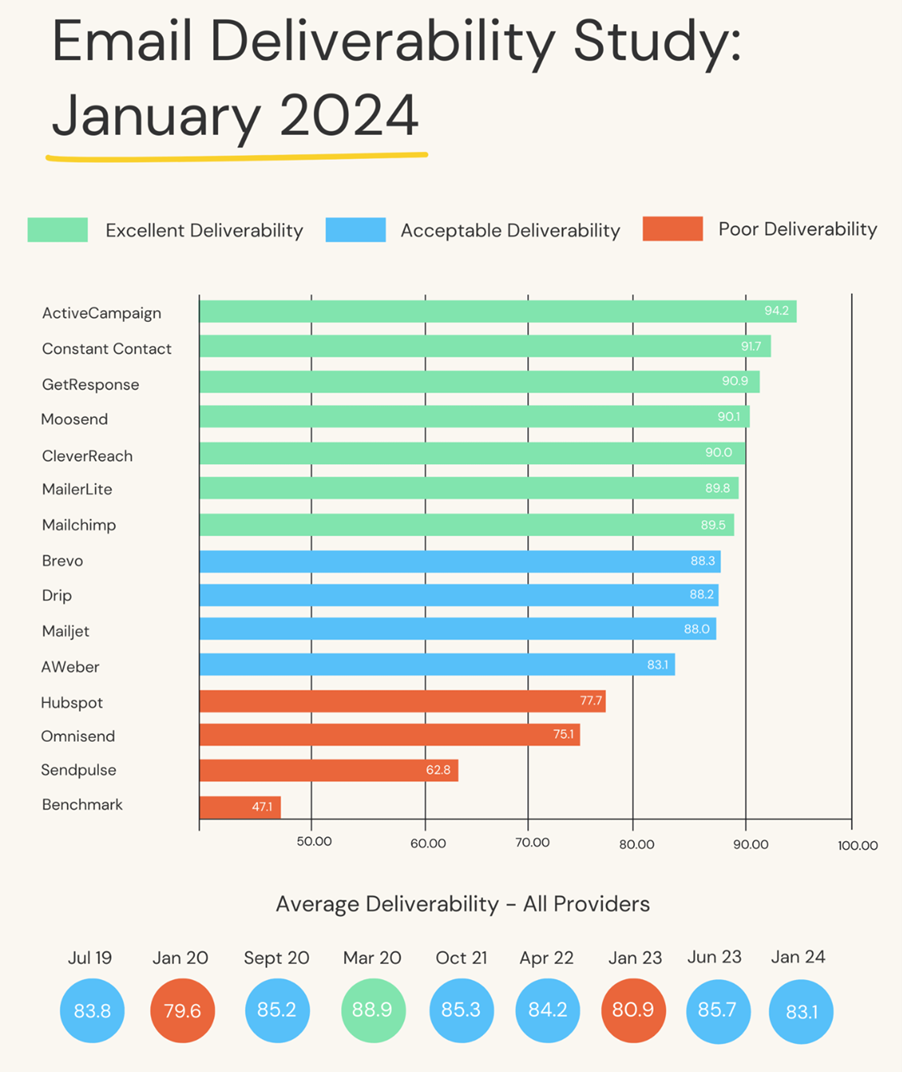Who is responsible for your deliverability?
Excellent tools. Poor deliverability?
Twice a year, the website EmailToolTester compares the deliverability of different email platforms.
For example, according to their report from January 2024, HubSpot, one of the most commonly used email platforms among startups, ends up with an unappealing score: "poor deliverability".
The method used to make the comparison was similar: using the same domain and setting a sub-domain for each email platform. Sending the same email to a seed list of approximately 80 seed records (using GlockApps) and receiving feedback on whether the email has landed in spam, blocked, reached the promotions tab, or the inbox of standard mailbox providers.
This method provides a simple deliverability comparison between ESPs but does not reflect real-life situations.
A list of 80 (or even 800) records cannot accurately represent email recipients engaging with emails. The seed list does not behave like a natural person. Many other factors affect deliverability in real life. The email platform's role in deliverability is essential, but it's not the only factor. The senders/marketers also play a significant role in building, improving, and maintaining their deliverability.
Is achieving excellent deliverability even with the so-called "poor deliverability" platforms possible? Absolutely.
That brings us to address the elephant in the room: Who is responsible for deliverability? And what are the relationships are between email platforms and their users.

Source: https://www.emailtooltester.com/en/blog/email-deliverability-test-jan-2024/
Does the platform control everything?
Many email marketers handle various digital marketing campaigns using several advertising and marketing platforms, such as Google and Facebook.
They click "send" on these platforms, and the platform handles everything else. Many marketers lack a clear understanding of how email functions and differs from other marketing channels, so they believe their email marketing platform (ESP) is just another marketing platform solely responsible for delivering emails to recipients' inboxes.
That usually takes some time, but when marketers realize their subscribers are not getting their emails because they are being blocked or landing in spam, they turn to the ESP and expect them to resolve the issues.
Many email platform users do not just blame the platform for any decline in their deliverability. They usually confuse deliverability with a visible metric – delivery (deducting failed-to-deliver emails from the total sent). Deliverability is all about getting emails to the subscriber's inbox, and it is tough to measure.
While senders must take responsibility for their deliverability, the ESP also plays a crucial role as an enabler for this to happen.
Are there deliverability differences between ESPs? Yes, but it's hard to make a fair comparation.
{box} The new bulk sender guidelines have been fully enforced since April 1st, 2024. In a new joint initiative between Google and Yahoo, nicknamed humorously "Yahoogle", a clear statement was made: complying with the new rules is a joint effort: some tasks email platforms need to carry out, and other marketers must handle.
ESPs are black boxes
Every ESP has a visible side, including all the UI (user interface), features, and functions. However, it is even harder to compare email marketing tools because they also have a hidden side, which is under the hood and usually plays its part after you hit send. As a user of the email platform, you typically don't know what's happening behind the scenes and don't have control over the emails you send. It's a black box. You know nothing about the ESP infrastructure. You don't know how many sending servers your ESP has or how they manage their servers and IP space. You don't know how many IP addresses your ESP owns (or if they are leased or ESP-owned), etc.
Most ESP customers (especially small and medium businesses) use a shared IP pool assigned to them by their ESP.
Email platforms suffer from "weak link syndrome": their platform deliverability is determined by their worst senders.
You don't know if the ESP maintains one pool of IPs for all senders (a swamp) or several quality-based IP pools based on many dynamic factors assessing the sender's behavior, assigning the best IP pool for their top senders, and allocating their worst pool for mediocre senders. Do you know what their policy is regarding bad actors?
Managing the IP pools is one of the significant challenges of every ESP, and there is a substantial difference between ESPs' approaches to that matter.
Email marketing is not as easy as your ESP makes it seem
Deliverability is a mystery thing, seldom hard to feel and measure.
Many deliverability issues are latent: they grow below the surface, and when they arise, it's sometimes sudden and excruciating.
Your ESP lacks a deliverability dashboard, often leading to oversight of existing deliverability issues.
However, deliverability issues, even if not visible in blood red, can significantly impact businesses, leading to financial losses without the businesses even realizing there is an issue.
Many ESPs offer customers the option to pay extra for hand glove onboarding assisted by the customer success team, and consulting services enjoy an advantage that most marketers do not receive. As a result, customers who pay for expensive premium services, including onboarding and setting up the ESP (domain authorization, system settings, integration, data migration, warmup, etc).
For all the rest, ESPs want their potential clients to buy their tools because they are easy to use, and email marketing is so powerful and easy with their tools. Everyone who has been in the email space long enough knows that email is powerful, yet it is not as easy, even with the best tools. ESPs typically offer their platform as a self-service tool and do minimal onboarding and educating effort (usually a series of emails and videos to watch).
Email marketing education opportunity
Most ESPs do not reflect to marketers how they (the ESP) assess them. In general, senders receive feedback from their ESP when they have done something silly.
Why not provide a dashboard for marketers to help them understand if they are going in the right direction? Are their sending practices good, and what should they do to get better resources and results from their ESP?
In my opinion ESPs should strive to educate all their users (not just the premium tier) on building and managing email programs with the best email marketing and deliverability practices.
Some ESPs have an academy of recorded classes and blogs from which their clients can learn. Nonetheless, they don't offer any motivation for learning or acknowledge exceptional students by granting them limited-time access to premium platform’s features or increased sending limits. Doing so can build long-term relationships between the ESPs and users while contributing to their user's email education.
Deliverability – two sides of the same coin
The sender is responsible for building and improving their reputation. It is also in their financial interest to understand the fundamentals of deliverability and know when it’s time to call a deliverability consultant to the table. From a deliverability standpoint, the email platform plays a role in ensuring the sender gets the best-in-class email tools. I have written an article for the OI blog with some deliverability in mind ideas that ESPs can leverage.
To summarize, both ESPs and senders are responsible for deliverability. It is a joint effort, and I hope ESPs compete not just on price and features but also on deliverability features, offering their clients tools that can make their less experienced users succeed.

Image Credit: MidJourney

 How to resolve AdBlock issue?
How to resolve AdBlock issue? 
